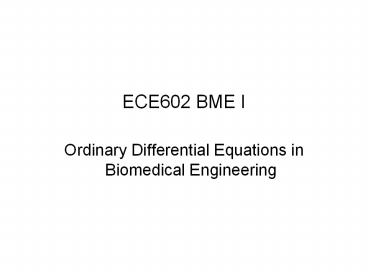ECE602 BME I
Title:
ECE602 BME I
Description:
... State Solutions and Stability Analysis. BME Example 1- The dynamics of Drug Absorption. BME example 2 Hodgkin-Huxley Model for Dynamics of Nerve Cell Potentials ... –
Number of Views:44
Avg rating:3.0/5.0
Title: ECE602 BME I
1
- ECE602 BME I
- Ordinary Differential Equations in Biomedical
Engineering
2
- Classification of ODEs
- Canonical Form of ODE
- Linear ODEs
- Nonlinear ODEs
- Steady-State Solutions and Stability Analysis
- BME Example 1- The dynamics of Drug Absorption
- BME example 2 Hodgkin-Huxley Model for Dynamics
of Nerve Cell Potentials
3
Classification of ODEs
- General Form of ODE
- The order of an ODE the order of the highest
derivative - R(t)0 Homogeneous R(t)?0 Nonhomogeneous
- Nonlinear an ODE contains powers of the
dependent variable, powers of the derivatives,
or products of the dependent variable with the
derivatives
4
Classification of ODEs
- Examples
First-order, linear, homogeneous
First-order, linear, nonhomogeneous
First-order, nonlinear, nonhomogeneous
Second-order, linear, nonhomogeneous
Second-order, nonlinear, nonhomogeneous
Third-order, nonlinear, nonhomogeneous
5
Canonical Form of ODEs
- Canonical form
- A set of n simultaneous first-order ODEs
- Required for methods for integrating ODEs
Vector format
6
Canonical Form of ODEs
Transformation to Canonical form
7
Linear ODEs
Matrix Exponential Method
8
Linear ODEs
EXPM Matrix exponential. EXPM(A) is the
matrix exponential of A.
gtgt syms t gtgt gtgt A1 1-1 1 y011 gtgt
yexpm(At)y0 y exp(t)cos(t)exp(t)sin(t)
-exp(t)sin(t)exp(t)cos(t)
9
Linear ODEs
Eigenvector matrix
Eigenvalue matrix
Method using eigenvalues and eigenvectors
10
Linear ODEs
EIG Eigenvalues and eigenvectors. X,D
EIG(A) produces a diagonal matrix D of
eigenvalues and a full matrix X whose columns
are the corresponding eigenvectors so that
AX XD.
gtgt syms t gtgt A1 1-1 1 y011 gtgt
X,Deig(A) gtgt y(Xexpm(Dt)inv(X))y0 y
exp(t)cos(t)-1/2i(exp(t)cos(t)iexp(t)sin(
t))1/2i(exp(t)cos(t)-iexp(t)sin(t))
1/2i(exp(t)cos(t)iexp(t)sin(t))-1/2i(exp(t
)cos(t)-iexp(t)sin(t))exp(t)cos(t) gtgt
ysimplify(y) y exp(t)(cos(t)sin(t))
exp(t)(-sin(t)cos(t))































